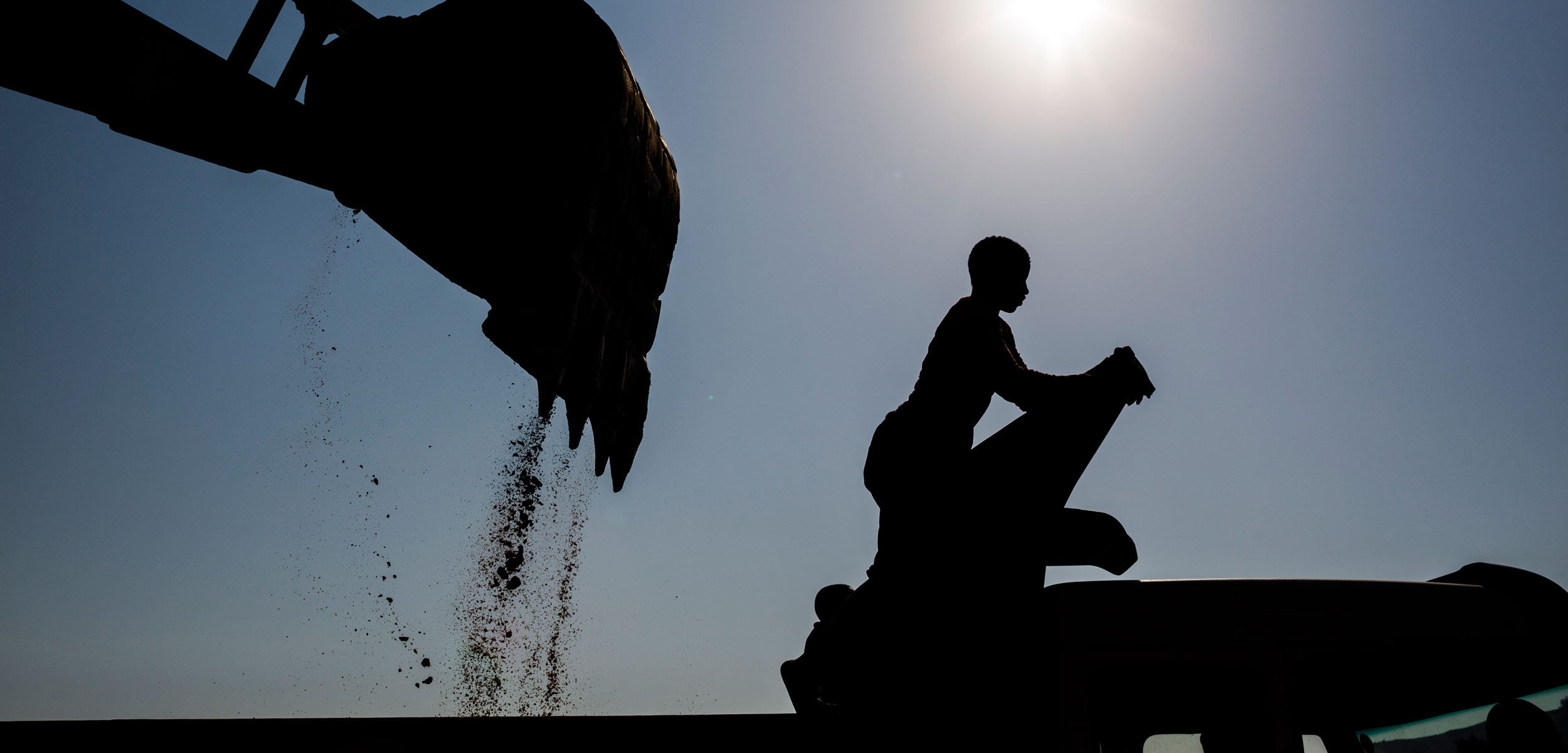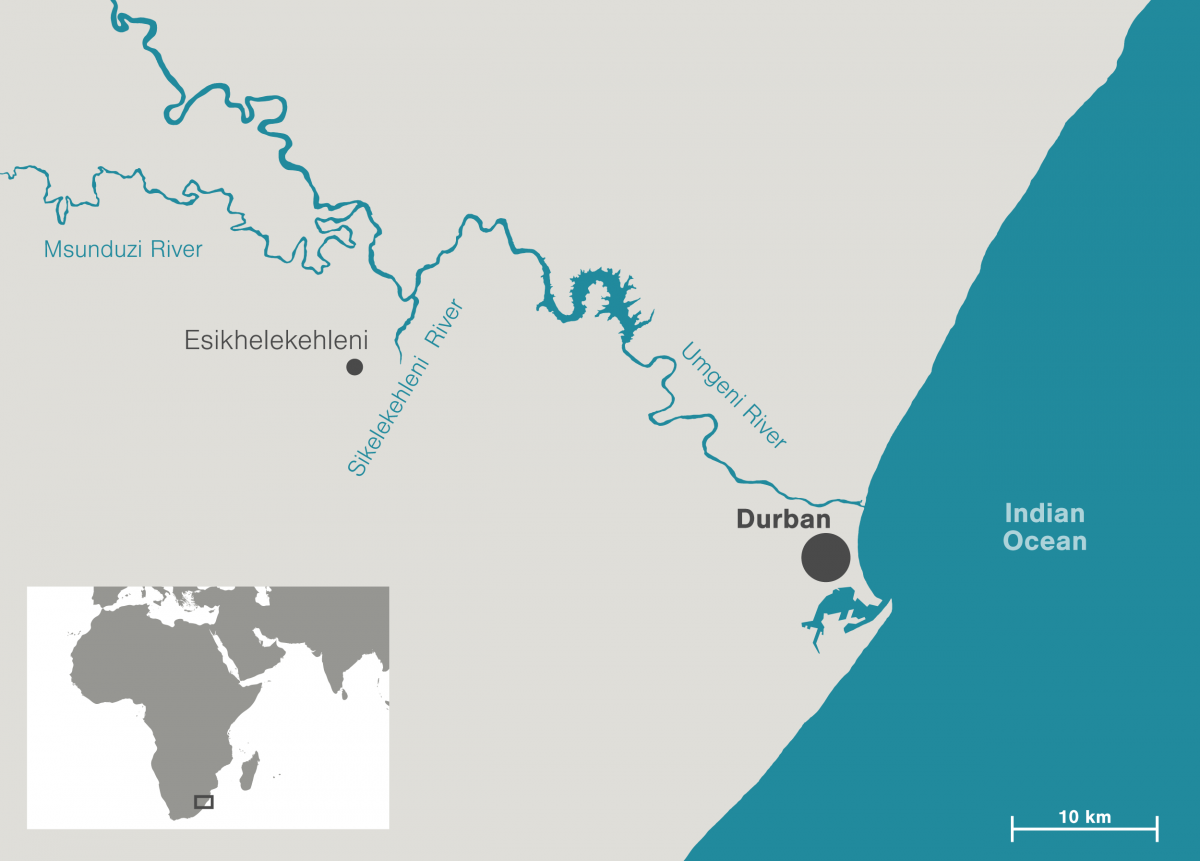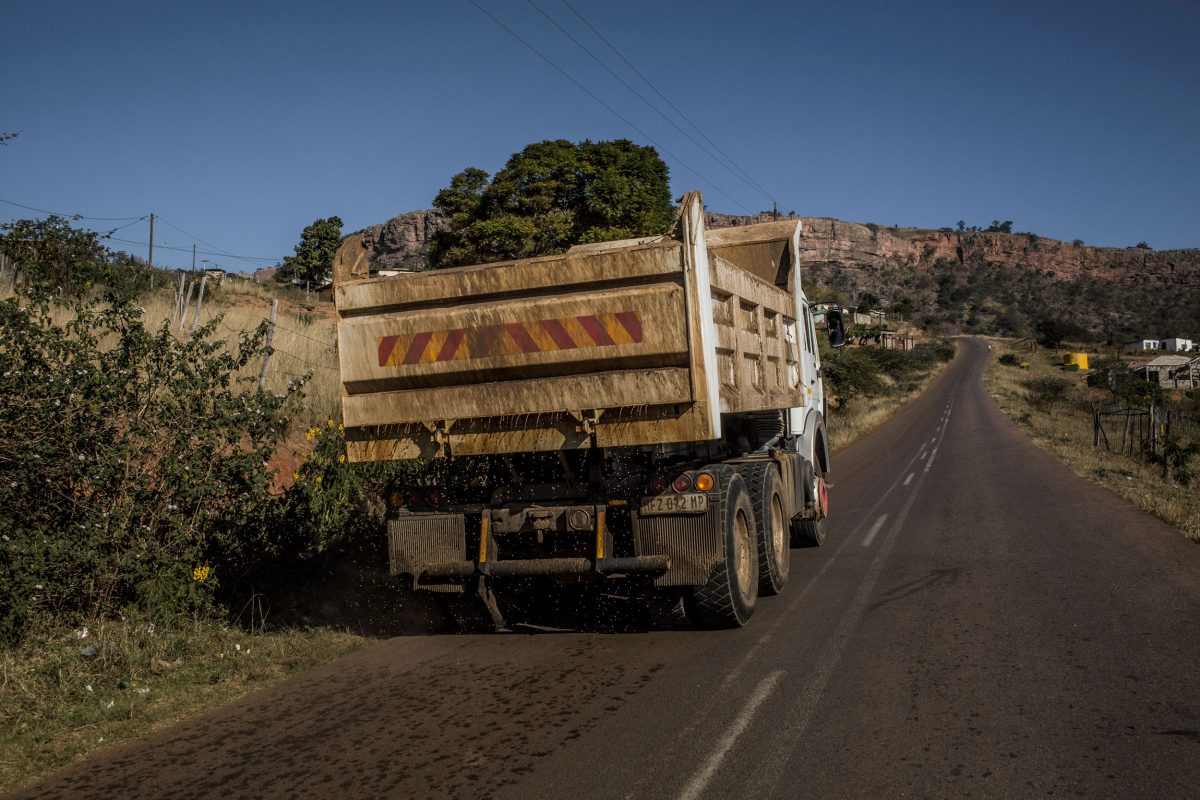Quick Sand, Dirty Money
Illegal sand mining in South Africa is starving beaches of sand, ruining rivers, and endangering lives.
Article body copy
Wiseman Mnguni squats in front of his lion, scraping its teeth with a plastic spoon. His leopard, buffalo, and rhinoceros face the promenade. It is early evening in Durban, a balmy port city on South Africa’s east coast, and the beachfront precinct, known as the Golden Mile, is packed. Teenagers on vacation take selfies outside the fast food stands as joggers thud by and surfers rinse off under outdoor beach showers. Lifeguards patrol the shore, blasting their whistles at errant swimmers. Hotel guests cross the road and sink their toes into the sand.
Mnguni, 33, keeps his head down amid the bustle, etching his lion’s snout into a snarl. For 12 years, he has sculpted animals and other elaborate sand structures on the beach, surviving on donations from passersby. His daily income ranges from US $4 to $8 on weekdays and reaches $15 on weekends, cash he splits with his assistant, a languid youth named Patrick Dlomo. He supplements these meager earnings by selling some of the cheapest advertising space in the city, smoothing large mounds into display boards and neatly lettering sentences with darker grains of sand. This July, he has adverts for a local auto body shop and a debt management firm, charging each company $20 for the month. When the wind blows, or if people damage the sculptures, he touches them up. “It’s no money,” says Mnguni, who supports his father, wife, and young son with his craft. “But it’s better than nothing. If we leave this, we have no job.”
Mnguni and Dlomo are among a ragtag group of sand artists who operate on Durban’s prized central beaches, subsisting at the fringes of a local tourism economy worth more than $400-million annually. At least three rival groups have stands along the six-kilometer brick walkway that winds the length of the coastal strip. Their sculptures repeat similar motifs—castles, big game animals, armchairs, cars—and are rendered with astonishing finesse. “This is a gift,” says Mnguni, who counts himself among the first sand artists in Durban. “Not just anybody can do it. You need a good brain.”
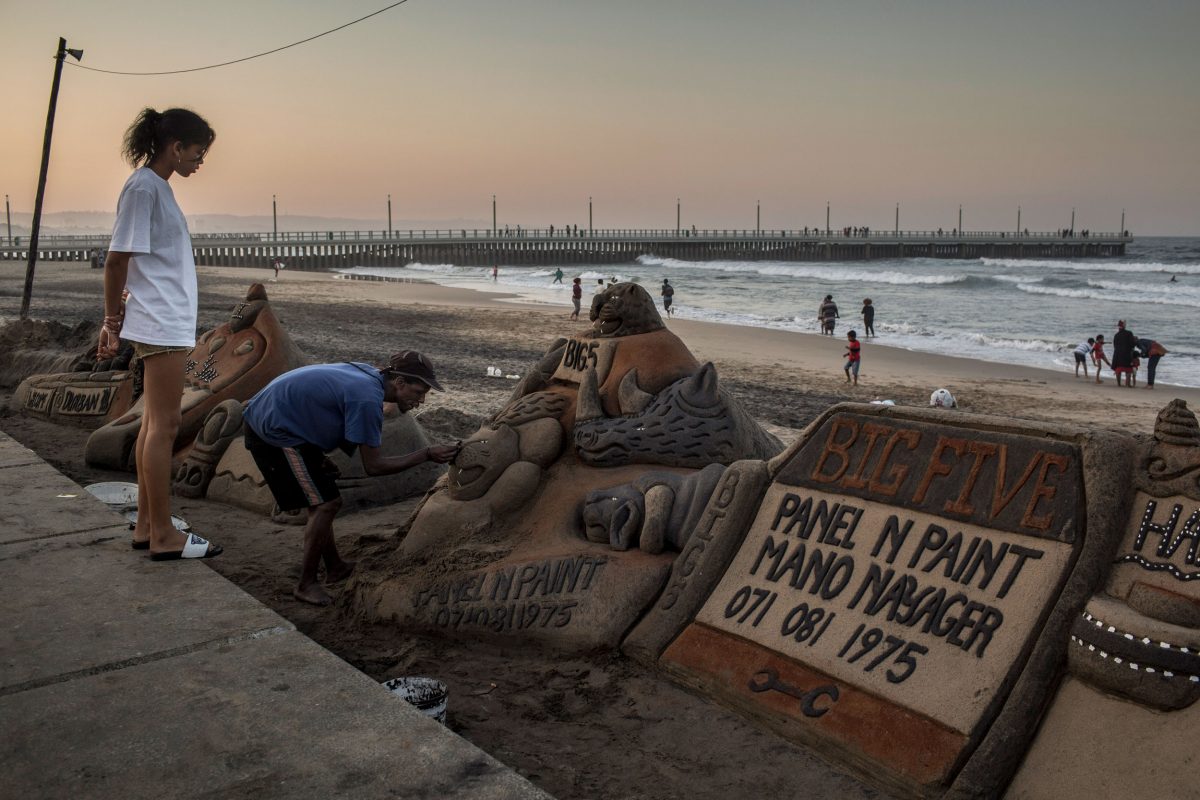
Several artists make their living as sand sculptors along Durban’s famous Golden Mile. As illegal sand mining starves the beach of sand, the artists’ raw materials may soon be in short supply. Photo by Charlie Shoemaker
You also need sand, which appears abundant but is diminishing due to unrestrained illegal mining in Durban’s rivers, the principal source of fresh sediment at the coast. Sand and gravel (collectively termed aggregates) are essential for the construction industry, used mainly for building roads and producing concrete. This has led to severe shortages worldwide. According to the United Nations, global aggregate use exceeds 40 billion tonnes per year, twice the volume of sediment carried by all the world’s rivers. As more and more sand gets cemented into the built environment, beaches like Durban’s are being stripped bare by the sea.
Mining has already cut coastal sand supply by as much as 70 percent in the municipality of Ethekwini, which includes Durban, according to a study by South Africa’s Council for Scientific and Industrial Research (CSIR)—repeating a pattern that is playing out around the world as cities spread. Each year, miners dig up more than 400,000 cubic meters of sand from Durban’s rivers, enough to fill 160 Olympic swimming pools. This sand would normally be deposited on beaches and help offset coastal erosion. At current mining rates, Durban’s beaches are predicted to contract, on average, by more than a meter each year.
This would have dire implications for the Golden Mile, one of South Africa’s busiest tourist destinations and an uncommonly integrated public space in a country still burdened by the legacy of apartheid. On this stretch of land reserved for whites less than 30 years ago, black skateboarders glide past sunburned bathers while Muslim mothers in burqas spread picnics on large blankets. Upstream, illegal mining threatens freshwater ecosystems and communities that depend on them. Yet sand remains cheap in monetary terms, not taking into account the far-reaching impacts of its overuse.
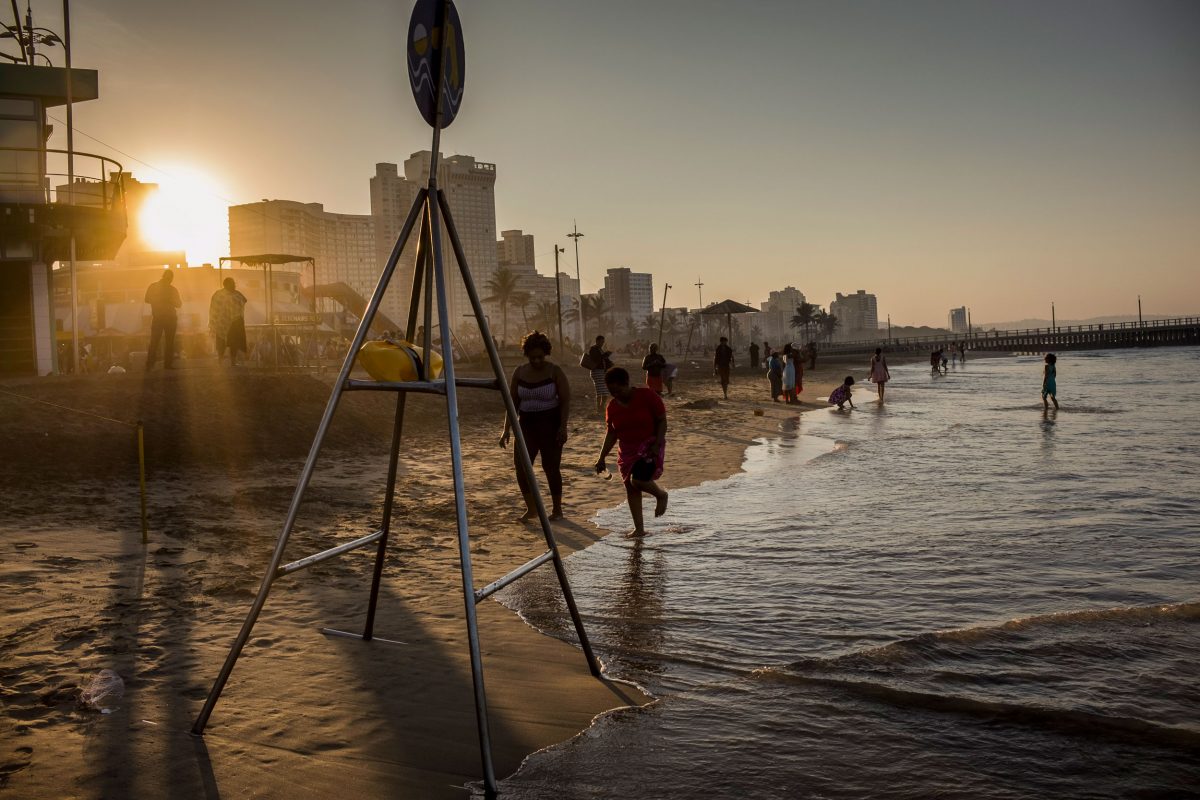
The city of Durban is famous for its sandy beaches and warm tropical waters, drawing tourists from Africa and elsewhere. Photo by Charlie Shoemaker
The CSIR estimates that Durban’s sandy beaches are worth over $15-million per kilometer per year, including the tourism and recreational revenue they generate as well as ecosystem services like erosion control. Estuaries where illegal mining takes place add further value by preserving biodiversity, recycling nutrients, and attenuating floods. There is a trade off between mining—which provides necessary construction material but irreversibly depletes sediment—and preserving these critical systems. The price of sand would increase tenfold if it included this full range of costs, the CSIR says.
Until such time as the price of sand rises, economic pressures sustain illegal digging, from the need for cheap building materials to high unemployment in rural areas, where miners risk injury for low pay and leave behind degraded, hazardous landscapes. There are direct links between these illegal operations and the construction industry, embedding the trade deep in mainstream development.
This trajectory leads to a future where rocks emerge as the beach dissipates, hardening the Golden Mile into a less accessible coast. Durban has already seen what this could look like. A violent surge in March 2007 wrought more than $76-million in damages along the beachfront, demolishing buildings and displacing some five million tonnes of sand.
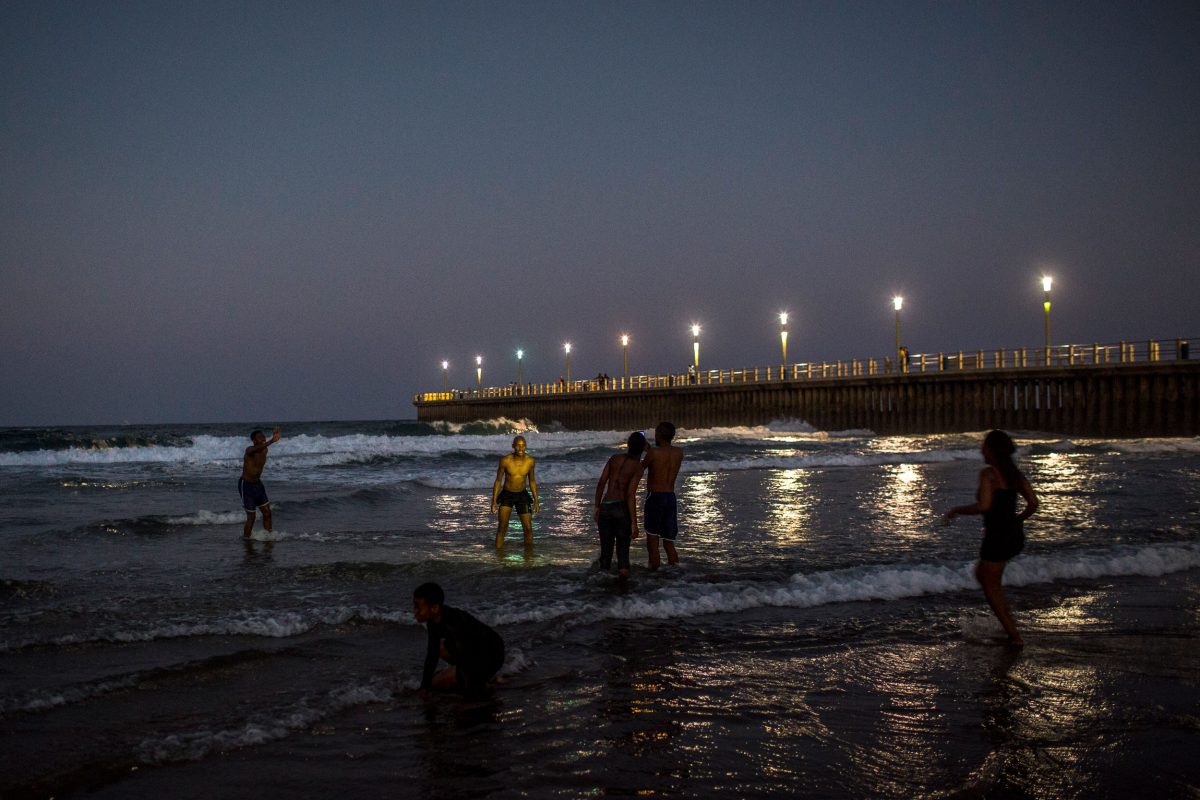
Teenagers take photos in the shallows at dusk. Illegal sand mining operations along rivers compromise the flow of sand downriver onto Durban’s beaches. Photo by Charlie Shoemaker
Yet the resource seems infinite as the sculptors fill their buckets and children dash through the shallows. The sand, weathered from sedimentary rock, is yellow brown, with black swashes of titanium ore farther up the beach. It clings to the skin and gathers in folds of clothing, sifting into vehicles and houses and hotel rooms. “You can’t use it up. There’s too much,” says Mnguni, dusting his hands. This is a pervasive belief: grains of sand typically represent abundance, not scarcity. He accepts a coin from a teenaged couple and poses for a photo while the ocean abrades the shore.
Thirty kilometers inland, on a wide bend in the Umgeni River, a mechanical excavator thrusts its claw into the water and hoists a dripping load of mud. A barefoot youth of 13 named Smiso sits at the controls for pocket money of $8 per day. He pivots the machine and dumps the mud to dry beside the channel, where three large trucks are waiting to fill up. Rutted dirt tracks crisscross the embankment, a barren sandy expanse once tangled with indigenous shrubs.
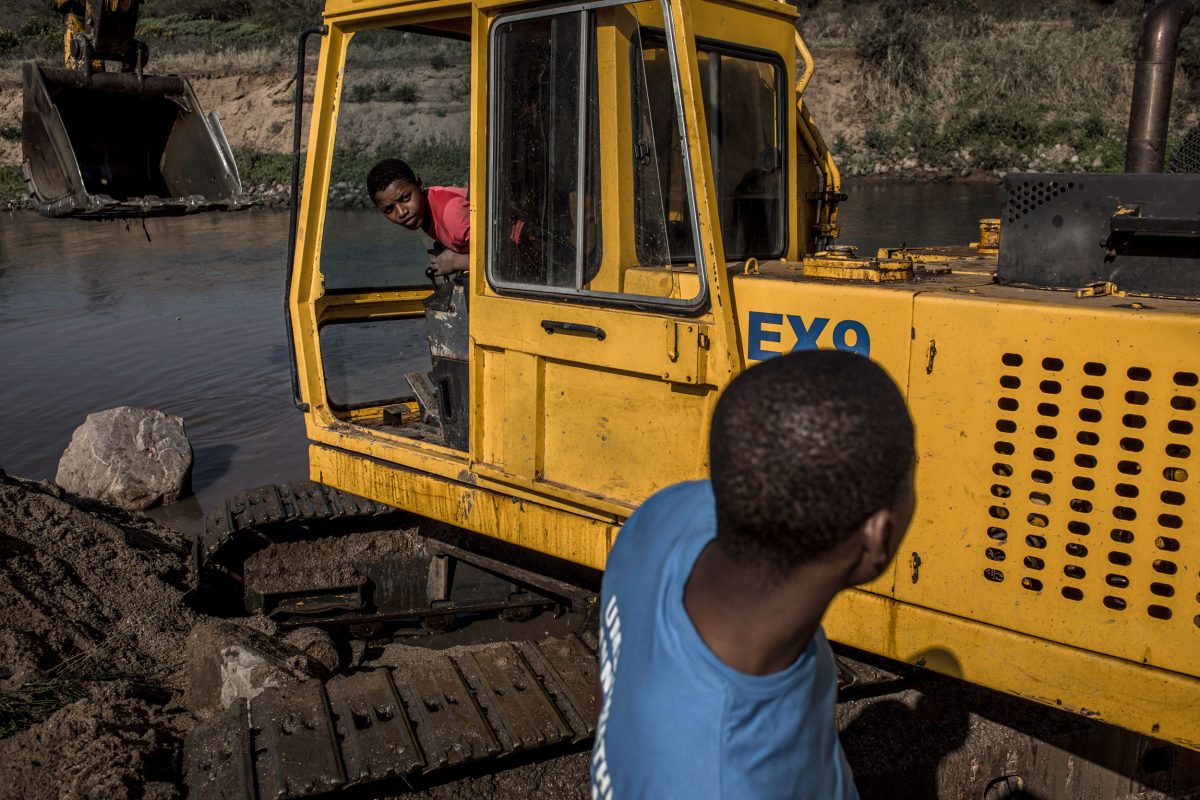
After removing fine-grained sand from the middle of the Umgeni River, a 13-year-old driver backs up an excavator. Photo by Charlie Shoemaker
Illicit mines have multiplied down the length of the Umgeni, a major river system that curls 225 kilometers through gray-green hills and meets the sea just north of the Golden Mile. The catchment supports five large dams and its name has been adopted by the provincial water utility, Umgeni Water. It has also become synonymous with a coarse, gritty builder’s sand that sells in most local hardware stores. (“Do you live near a river that got Umgeni Sand? I require truckloads,” reads one recent online classifieds post.) Ecologically, the river is considered one of Ethekwini’s most vulnerable, threatened by habitat loss, pollution, and the spread of invasive species. Operating in a vacuum of unemployment, which exceeds 40 percent in the province, illegal mining has amplified these stresses, impairing the Umgeni’s critical services while posing direct threats to the communities settled on its banks.
The excavator leaks a trail of hydraulic oil as Smiso maneuvers it back onto the riverbank. The ground shakes as he lumbers toward the trucks and begins loading them. Two barefoot men—like him residents of the nearby village, a clutch of thatched homes farther up the slopes—clamber up to flatten the heaps with shovels, the mechanical arm of the excavator swinging centimeters above their heads. Dirt and diesel smoke fill the air. The chug of the engines is deafening. As soon as they finish, the trucks depart, hauling the riverbed away.
Sitting on a bucket in the noonday heat, a young woman with braids and gold-tipped teeth watches the men work, writing sums in a neat ledger. The mine belongs to her older brother, a man called Mbambo; she acts as his site manager, recording sales and collecting payment. Her book shows that 25 trucks purchased sand the previous day, representing a total yield of more than 75 tonnes. “It wasn’t very busy,” she says. “Often we sell more.”
Officials say Mbambo runs a second, larger illegal mine several kilometers upstream. He has no overheads besides hiring excavators ($270 per day) and buying diesel, with negligible labor costs. Each truckload of sand sells for $20 to $30. His profits from each site comfortably exceed $3,000 per month. Though he has been warned several times to stop operating, Mbambo continues digging up rivers, knowing that he is unlikely to be punished. Like in many other developing countries, sand mining enforcement is lax in South Africa, with few consequences for breaking the law.
To comply with national mining legislation, legally operating sand miners must apply for permits from the Department of Mineral Resources (DMR), submit environmental management plans, and pay deposits for rehabilitation. Mines larger than 1.5 hectares must commission environmental impact assessments and prepare social and labor plans, including provisions for skills development, severance packages, and equity targets. Separately, miners are supposed to seek formal permission from environmental and land use authorities, although in practice these requirements are often flouted. “Illegal miners act with impunity,” says one official, requesting to remain anonymous.
Stewart Green, a former Department of Environmental Affairs employee who wrote a master’s thesis on sand mining in 2012, argues that this is largely due to poor cooperation between different state agencies, with a particular lack of effort from DMR. There is also a shortage of compliance officers, meaning that illegal sand miners are seldom investigated or charged. The ease with which sand can be sold makes policing the trade even more difficult. Illicit mining of other valuable minerals—gold, diamonds, chromium—is worth over $500-million annually in South Africa, but these products require elaborate criminal networks to penetrate legal markets. Sand, by comparison, often travels directly from rivers to construction sites.
One of the drivers loading at Mbambo’s mine, a man named Jabulani, is delivering to a rural housing scheme 30 kilometers away. He drives for several hours, inching up potholed dirt tracks in low gear before merging with an arterial road. The truck is in bad repair and moves slowly, arriving late in the afternoon. Set on a steep hill, the site is crowded with teams of workers laying pipes and digging foundations; the new walls, erected to address chronic housing shortages, hold untold tonnes of sand.
“Most contractors don’t want to know where the stuff comes from. They just take the cheapest option,” says Doug Burden from the Duzi-Umngeni Conservation Trust (DUCT). The group was formed by a group of paddlers to combat degradation along the route of Africa’s largest canoe marathon, which follows the Umgeni and one of its largest tributaries, the Msunduzi. “We’d stand, beers in hand, on the deck at the clubhouse, bitching about the state of the river,” Burden says. “Then someone suggested getting involved.”
Seeking to disrupt flows of ill-gotten aggregate, DUCT has developed proposals for sustainable mining schemes, approaching construction firms for support. “We encouraged them to source sand extracted from the headwaters of dams, where sediment constantly accumulates,” says Burden. “That way, the illegal miners would have fewer people to sell to. It would hit them in the pocket. But we couldn’t get the main players on board. At the end of the day, the sector is still driven by money and greed.”
With little accountability in construction supply chains, illegally mined sand can vanish into all manner of legitimate projects. The Ethekwini municipality, tasked with preventing environmental damage due to sand mining, has in the past subcontracted illicit suppliers for repairs to its own offices. “It’s a huge irony,” says one official. “We’re busy fighting these guys and then we see their trucks pulling up outside.” Burden attributes a dramatic illegal mining surge in 2008 to the construction of Moses Mabhida Stadium, a 2010 FIFA World Cup venue that absorbed more than 245,000 tonnes of concrete.
That figure is small when compared to the amount of concrete produced during South Africa’s construction boom of the 2000s, when the sector expanded by an average 10 percent annually—more than twice the GDP growth rate—before the global financial crisis of 2008. At its peak in 2007, the industry consumed more than 90 million tonnes of gravel and sand: enough to fill a line of 10-meter trucks, squashed nose to tail, stretching six times around the equator.
Yet illicit miners have been targeting Durban’s river valleys since long before the construction sector ignited. They move onward as they deplete sediment, leaving abandoned pits in their wake. These pits have no fences and can plunge deeper than four meters into the riverbanks. In the summer rainy season, from October to March, they fill with river water, forming murky pools. It was in one such pool on the Umgeni that Sibangani Zondi, 14, went swimming on January 25, 1996, during the first week of the school year. He jumped in with his friends after class and sunk quickly, drowning less than 200 meters from the school gate.
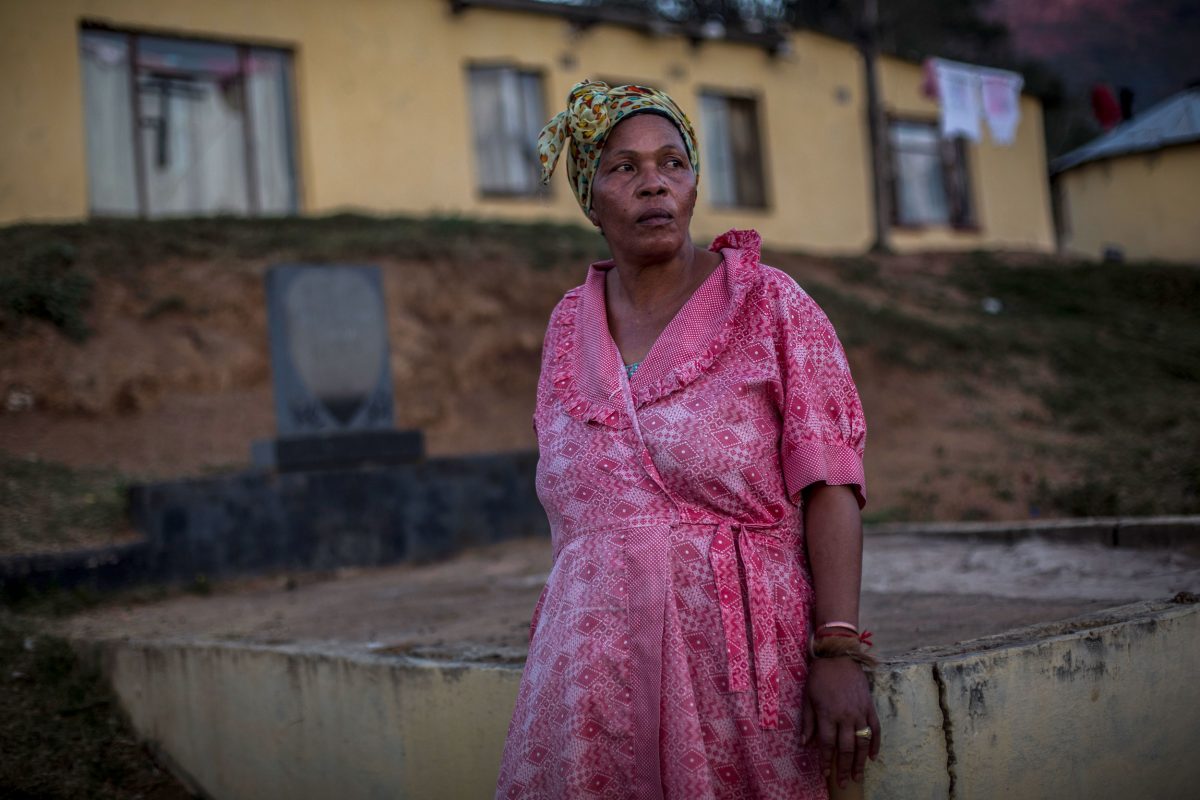
Joyce Zondi stands in front of her son’s grave outside her home. In 1996, Zondi’s son Sibangani drowned in a water-filled hole at an illegal sand mine. Photo by Charlie Shoemaker
“The mine bosses showed no remorse,” says Sibangani’s mother, Joyce, standing beside his grave at her home in Esikhelekehleni, an impoverished rural settlement high above the Umgeni River. Sibangani was her eldest child; he would have turned 35 this year. “They refused to contribute to his funeral. They said that children must stay away from the mines, that they can’t do anything to stop them.”
Court documents from an illegal sand mining case in 2013 show that Durban police had received reports of approximately 11 children drowning in unsecured pits by 2010. These deaths have had little effect on the trade. To this day, trucks eke uphill not far from Sibangani’s grave, shredding a narrow access road not built for heavy freight. Mud dribbles onto the tarmac, smearing the ascending lane dull brown. The trucks return empty, racing downhill to the Sikelekehleni, a smaller tributary of the Umgeni that has been illegally mined for more than 15 years. Boulders rise from beds of invasive reeds, with empty furrows collecting stagnant water, in the five-kilometer scar running up its banks.
One evening, as dusk falls, an excavator scrapes a final load from the channel and cuts its engine. The stream has been replaced by a pool of oily quicksand. Rocks tossed from the embankment provoke no ripples in the dense sludge. An old man guarding the site says cattle often fall in and get trapped. “People don’t like this mine. It creates too many problems. So they come here at night and damage the machines,” he says. “I feel the same—but I need money, so I took the job.”
Similar pressures have driven hundreds of villagers to join the sand trade, though working conditions are often dangerous. During apartheid, the South African government created “homelands” for black ethnic groups, reserving 87 percent of the land for ownership by whites. The effects of this dispossession are still widely visible, with high levels of poverty in tribal areas. Today, a third of the Ethekwini municipality is governed by traditional Zulu authorities, a system that has produced several loopholes. For example, miners have requested, and in some cases paid for, permission to dig on tribal land, even though traditional authorities do not have the power to override national mining and environmental laws.
This leaves miners vulnerable to accidents, injuries, and sudden dismissal—all without the regulatory safeguards of a formal industry. In July 2001, Jabulani Miya was shoveling sand onto a portable conveyor belt when his jacket got trapped in the machine, mangling his right arm. Doctors later amputated the limb above the elbow. Miya’s boss refused to employ him or pay any compensation when he got out of hospital five months later. “He said I was useless,” says Miya, who had been digging on the Sikelekehleni River for almost 10 years.
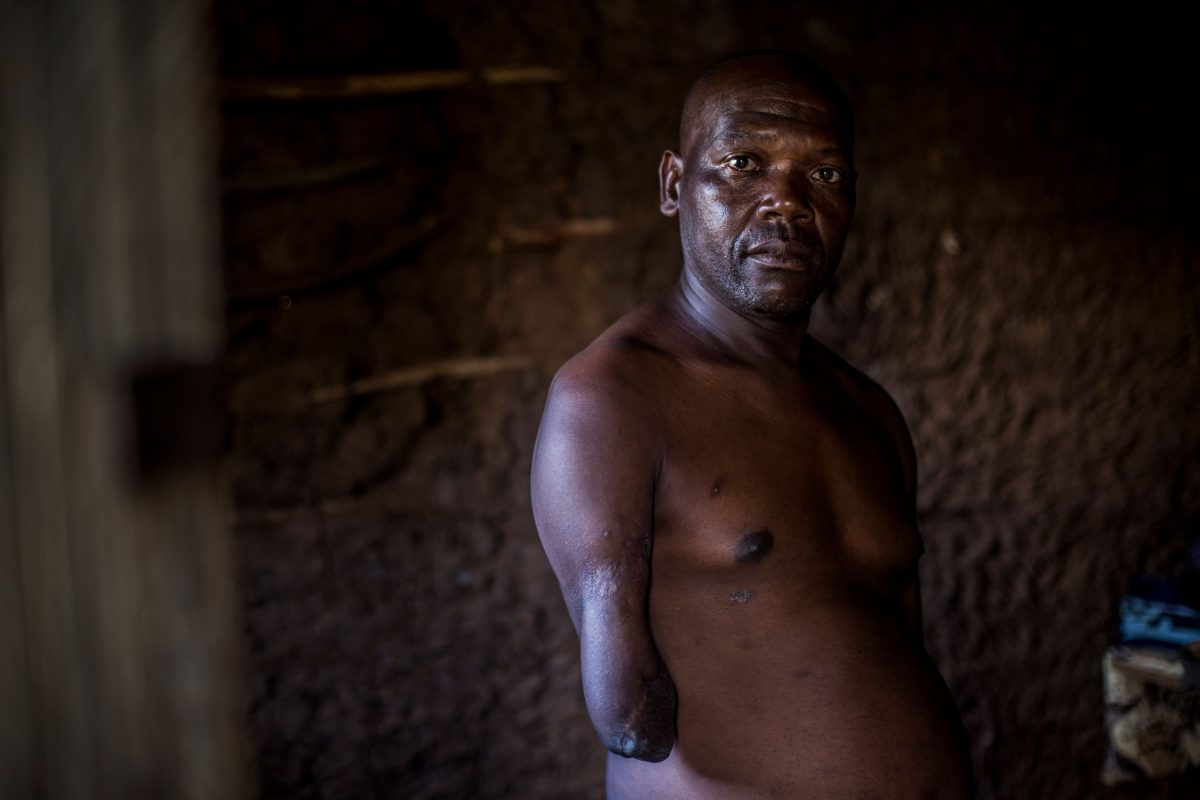
Former sand miner Jabulani Miya lost his arm in 2001, while working on an illegal sand mine along the Sikelekehleni River. Photo by Charlie Shoemaker
His home, a single-room mud structure, looks down the valley toward the site of his injury. Dust clouds rise as the trucks come and go. Miya, 46, has been unable to find work since losing his arm and survives on a state disability grant of around $115 per month. His mother lived with him until passing away this May; her unmarked grave lies a few meters from the house. “I can do my own laundry and cook pap [maize porridge],” Miya says, “but I can’t chop food. I can’t do what most people can.”
His right shoulder is withered from disuse, giving a slight tilt to his broad frame. The damaged arm hangs at his side, wrapped in a fabric dressing. An older cousin named Nicholas helps him now, sleeping beside him at night on a thin mat. “He was very strong; he loved sports and physical work,” Nicholas says. “He hates being like this. Sometimes he just cries. When he starts talking about what happened, he can’t finish what he’s saying.”
Spurred on by the relentless expansion of cities, our hunger for sand has harmed people and ecosystems around the world. (Violent sand mafias in India, for example, have murdered police officers, activists, and a reporter to maintain control of an industry worth billions annually.) With sand and gravel accounting for up to 85 percent by weight of all material mined on Earth, humans now consume more aggregate than any other resource besides water and air. Grains of desert sand are too fine and rounded to adhere to cement, leaving rivers and beaches as the main source for producing concrete.
Behind these direct human costs of sand mining, more subtle losses are taking place. Rivers turned cloudy with sediment no longer support the same biological communities, and invasive plants establish on denuded banks. Floods rip through valleys more fiercely, scraping away precious topsoil. The value of a river is most evident when it is gone.
On South Africa’s east coast, the Umgeni drains into the ocean after cutting through crowded townships and an industrial zone at the edge of the city. It passes at least four active mines, and countless others that have been abandoned, between its confluence with the Sikelekehleni River and the coast. Anglers congregate at the river mouth after dark, casting lines by flashlight into waters starved of sediment. Four kilometers down the beach, huddled along the promenade, the artists tend to their sculptures as the mist creeps in.
Wiseman Mnguni’s wife, Mpume, sits next to him as he tamps down loose sections and carves fresh patterns in the sand. She accompanies him to the beach some days to carry buckets and collect tips, traveling an hour by taxi in each direction. The wind tugs at her scarf as she watches the beggars outside the restaurants and the brightly lit hotels. Her husband barely looks up, pressing his palms against the damp sediment. Tomorrow his sculptures must be immaculate, ready for the returning crowds.
Reporting for this story was supported with a Taco Kuiper grant from the Wits Journalism program, in South Africa.

